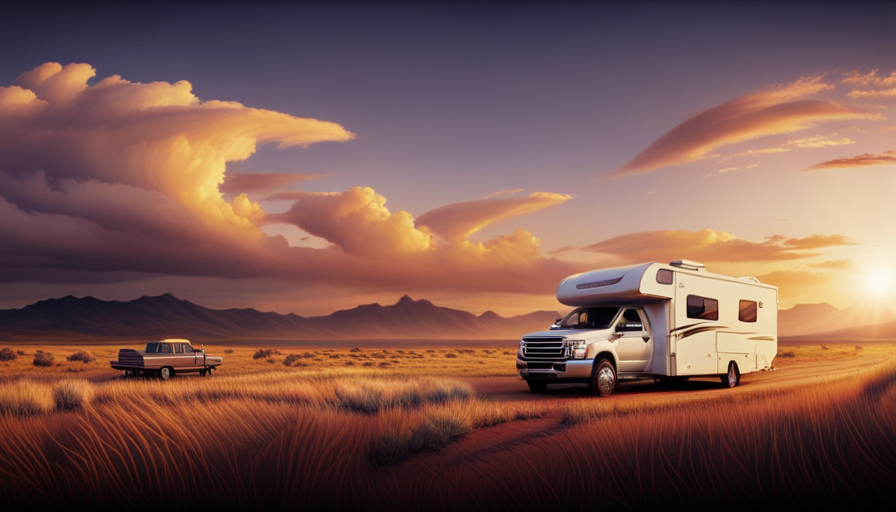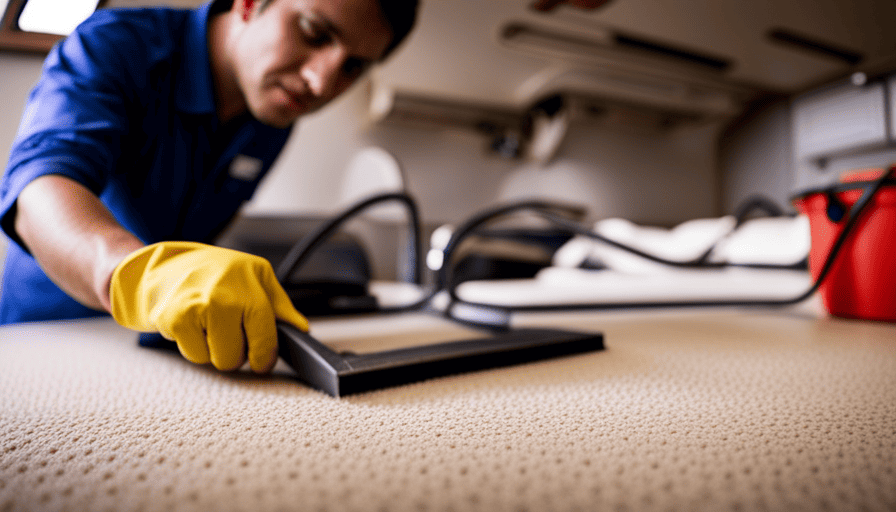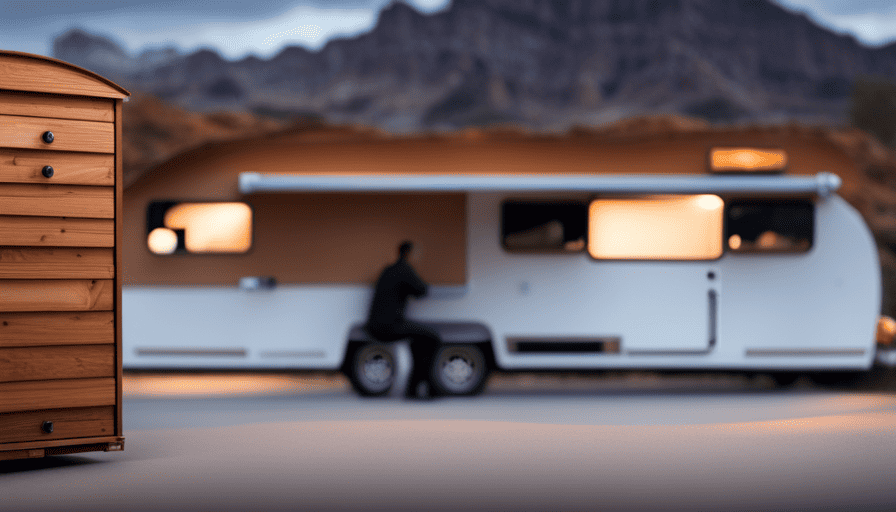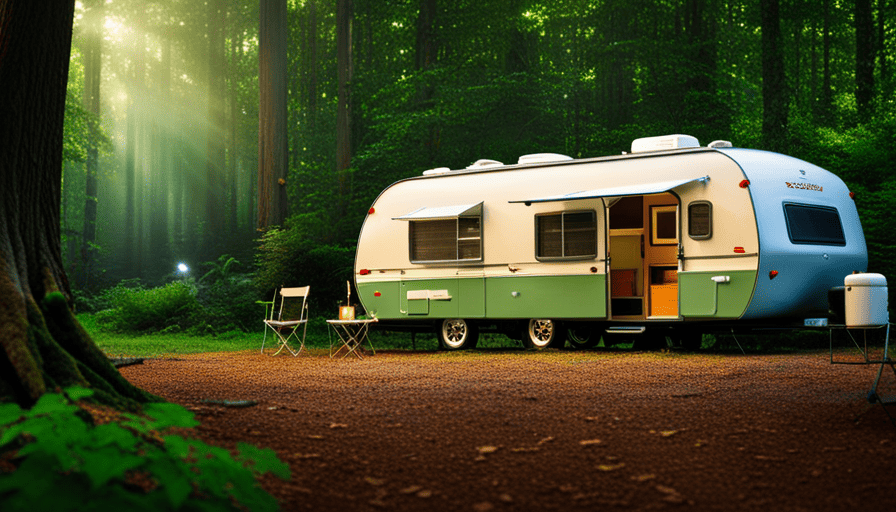Are you gearing up for an unforgettable journey with your truck camper? The open road and the vast wilderness are calling! However, before you set off on your adventure, it’s essential to make sure your truck camper is properly secured. Don’t worry; our comprehensive guide on securing a truck camper will walk you through the process step by step.
Picture this: you’re cruising down the highway, wind in your hair, and the open road ahead. Suddenly, you hit a bump and your beloved truck camper starts swaying dangerously. It’s a nightmare scenario, but fear not! With the right equipment and know-how, you can prevent this from happening.
In this article, we’ll walk you through the process of assessing your truck camper’s weight and dimensions, gathering the necessary tools, and securing the camper to the truck bed. We’ll also cover how to use ratchet straps or tie-downs effectively and install stabilizer bars or jacks for added support.
Safety is paramount, so we’ll highlight the importance of following guidelines and regulations. Plus, we’ll share tips on inspecting and maintaining your tie-down system regularly.
Get ready to hit the road with confidence, knowing that your truck camper is securely tied down.
Let’s dive in!
Key Takeaways
- Assess the weight and dimensions of the truck camper before securing it.
- Choose appropriate tie-down points and gather necessary equipment for securing the camper.
- Install tie-down brackets, turnbuckles, and anchor bolts to ensure a secure connection.
- Use ratchet straps or tie-downs to prevent shifting of the camper and double-check the tightness of all tie-downs and supports before traveling.
Assess Your Truck Camper’s Weight and Dimensions
Before you start tying down your truck camper, it’s crucial to accurately assess its weight and dimensions to ensure a safe and secure journey. Assessing weight distribution is essential to determine how the camper will sit on your truck bed. This will help you understand how much pressure will be exerted on each tie-down point.
Start by measuring the overall length, width, and height of your truck camper. This will allow you to identify any potential clearance issues or modifications that need to be made. Additionally, determine the weight of your camper using a scale specifically designed for this purpose. Distribute the weight evenly across the truck bed to maintain balance and prevent excessive strain on specific areas.
Choosing appropriate tie-down points is another critical aspect of securing your truck camper. Inspect your truck bed and camper for manufacturer-recommended attachment points. These are usually reinforced areas specifically designed to handle the weight and stress of securing a camper. If your camper does not have designated attachment points, consult with a professional or experienced camper owner to identify the safest options.
Once you have assessed your truck camper’s weight and dimensions and have chosen appropriate tie-down points, you can move on to the next step of gathering the necessary equipment and tools for securing your camper.
Gather the Necessary Equipment and Tools
To properly secure your truck camper, you’ll need to gather all the essential gear and tools. Choosing the right tie down equipment is crucial to ensure a safe and secure journey.
You’ll need four sturdy tie down brackets, four turnbuckles, and four anchor bolts. These will serve as the foundation for securing your camper to the truck bed. Additionally, make sure to have a drill, socket wrench, and tape measure on hand for the installation process.
First, measure the length and width of your truck bed to determine the ideal placement of the tie down brackets. Position them towards the corners of the bed for maximum stability. Use the drill and anchor bolts to securely attach the brackets to the bed.
Next, attach the turnbuckles to the brackets and camper. These adjustable devices will allow you to tighten the tie downs and keep your camper firmly in place during transportation. Make sure to follow the manufacturer’s instructions for proper installation of the turnbuckles.
Once you have gathered all the necessary equipment and completed the installation process, you can proceed to secure the truck camper to the truck bed. This will ensure a safe and worry-free journey to your destination.
Secure the Truck Camper to the Truck Bed
Once you’ve gathered all the necessary equipment and completed the installation process, it’s time to fasten your truck camper securely to the bed of your vehicle. Securing a camper to the truck bed requires careful attention to ensure a safe and stable journey.
There are various truck camper tie down techniques that can be used depending on the type of camper and truck bed you have. One common method is to use camper tie down brackets that attach to the frame of the truck. These brackets provide a solid anchor point for the camper and help distribute the weight evenly. Another method for anchoring a camper is to use turnbuckles and adjustable bars that connect the camper to the truck bed. This allows for flexibility in adjusting the tension on the tie downs to ensure a secure fit. Some truck campers may also utilize a combination of brackets, turnbuckles, and adjustable bars for added stability when anchoring a camper. These techniques can help ensure that the camper is securely fastened to the truck bed, making for a safe and stress-free travel experience. Another popular option is to use turnbuckles to secure the camper to the brackets, providing added stability during travel. Additionally, some campers may require additional support such as stabilizing jacks to secure camper to ground and prevent any wobbling or shifting while parked. It’s important to carefully choose the appropriate tie down techniques and equipment to ensure the safe and secure transportation of your truck camper.
Another option is using turnbuckles, which are adjustable metal rods that connect the camper to the truck bed. Turnbuckles allow for easy tension adjustments to keep the camper secure during travel.
In addition to these techniques, it’s important to use ratchet straps or tie-downs to secure the camper from shifting side to side or front to back. These straps should be attached to anchor points on the camper and the truck bed, ensuring a tight and secure connection.
By using these truck camper tie down techniques and securing your camper properly, you can have peace of mind knowing that your camper will stay in place while on the road.
Transitioning to the next section, let’s talk about how to use ratchet straps or tie-downs to secure the camper without compromising its stability.
Use Ratchet Straps or Tie-Downs to Secure the Camper
Now that you’ve got everything set up, it’s time to get those bad boys strapped down and ready for the open road. Securing your truck camper is crucial to ensure a safe and smooth journey. There are different types of ratchet straps or tie downs available in the market, each designed to provide maximum stability and security.
Here are three options to consider:
-
Cam buckle straps: These straps are easy to use and adjust. They have a quick-release mechanism that allows for quick tightening and loosening. Make sure to choose straps that have a high weight capacity and are specifically designed for securing truck campers.
-
Ratchet straps: These straps are known for their strength and durability. They have a ratcheting mechanism that allows for precise tensioning. When using ratchet straps, it’s important to properly thread the strap through the ratchet and tighten it securely.
-
Turnbuckles: These are specially designed for truck campers and provide exceptional stability. They have a threaded shaft that can be adjusted to tighten the strap. Make sure to choose turnbuckles that are compatible with your truck camper’s anchor points.
When securing your truck camper, it’s important to avoid common mistakes such as using worn-out or damaged straps, not tightening the straps enough, or over-tightening them. These mistakes can compromise the stability of your camper and lead to potential accidents.
Now that you’ve securely strapped down your truck camper, it’s time to consider adding stabilizer bars or jacks for added support.
Install Stabilizer Bars or Jacks for Added Support
For an extra layer of support and stability during your journey, consider installing stabilizer bars or jacks to keep your camper steady. These alternative stabilizing options can provide added security and minimize any sway or movement while on the road.
When choosing the right stabilizer bars or jacks, there are a few tips to keep in mind. Firstly, consider the weight and size of your truck camper. Stabilizer bars or jacks should be specifically designed to handle the weight and dimensions of your camper. It’s important to choose ones that are capable of providing sufficient support.
Additionally, think about the ease of installation and adjustability. Look for stabilizer bars or jacks that are easy to install and can be adjusted to fit your camper’s height and configuration. This will ensure a secure and snug fit.
Furthermore, consider the durability and quality of the stabilizer bars or jacks. Look for ones made from high-quality materials that can withstand the rigors of the road and provide long-lasting support.
By installing stabilizer bars or jacks, you can enhance the stability and support of your truck camper. Once these are in place, it’s important to double-check the tightness of all tie-downs and straps to ensure everything is secure before hitting the road again.
Double-Check the Tightness of all Tie-Downs and Straps
Ensure that every connection and fastening is tightly secured, like the links of a chain, to guarantee the unwavering stability of your adventurous mobile home. Tie down strength is of utmost importance when it comes to securing your truck camper. Proper tie down technique ensures that your camper stays in place, even during rough terrains or sudden stops.
To double-check the tightness of all tie-downs and straps, start by examining each connection point. Make sure that all bolts and nuts are securely fastened and tightened. Inspect the ratchet straps or chains for any signs of wear or damage, and replace them if necessary. Give each strap a firm tug to ensure that it is snug and secure.
Next, check the tension of the tie-downs. They should be tight enough to hold the camper firmly in place but not so tight that they cause damage. Use a tension gauge to measure the tension and adjust accordingly.
Properly securing your truck camper is crucial for a safe and enjoyable journey. By following these steps and ensuring the tightness of all tie-downs and straps, you can have peace of mind knowing that your home on wheels is securely fastened.
As we move on to the next section about testing the stability of the truck camper, let’s explore how to ensure that your camper is securely in place before hitting the road.
Test the Stability of the Truck Camper
To make sure your adventurous mobile home is securely fastened, it’s important to test the stability of your camper before hitting the road. Testing the stability will give you peace of mind knowing that your camper is securely attached to your truck and won’t shift or become unstable during your journey.
There are several test methods and stability indicators you can use to ensure your camper is secure. First, check for any excessive movement or rocking by gently pushing and pulling on the camper from different angles. If you notice any significant movement, it’s a sign that your tie-downs may need to be adjusted or tightened. Additionally, pay attention to any unusual noises or vibrations, as they can indicate a lack of stability.
Another test method is to take your camper for a short test drive in a safe, open area. Observe how it handles during turns, accelerations, and sudden stops. If you notice any swaying or shifting, it’s a clear sign that the tie-downs need to be readjusted to improve stability.
Once you have tested the stability of your truck camper, you can proceed to adjust and fine-tune the tie-downs as needed. This will ensure that your camper is securely fastened and ready for your next adventure on the road.
Adjust and Fine-Tune the Tie-Downs as Needed
Fine-tuning the tie-downs ensures a secure and stable connection between your adventurous mobile home and your vehicle. Here are a few adjustment techniques and troubleshooting tips to help you achieve the perfect fit:
-
Check the tension: Start by inspecting the tension on each tie-down. You want them to be snug but not overly tight. Adjust the tension as needed to ensure a secure hold without causing any damage.
-
Verify the angles: Take a look at the angles of the tie-downs. They should be straight and not twisted or kinked. If you notice any issues, adjust the positioning or replace any damaged components.
-
Consider weight distribution: Pay attention to the weight distribution of your truck camper. Uneven weight can affect the stability of the tie-downs. Adjust the positioning of your cargo or use additional support to achieve a balanced load.
By fine-tuning the tie-downs and addressing any issues, you’ll have peace of mind knowing that your truck camper is securely fastened.
Now, let’s move on to the next section and discuss the importance of following safety guidelines and regulations.
Follow Safety Guidelines and Regulations
Now that we’ve adjusted and fine-tuned the tie-downs as needed, let’s move on to the next crucial step in tying down a truck camper: following safety guidelines and regulations.
Ensuring the safety of your truck camper is of utmost importance to prevent accidents and damage while on the road. First and foremost, it’s essential to familiarize yourself with the safety guidelines and regulations set by your local transportation authority. These guidelines typically cover aspects such as weight restrictions, maximum height, and proper tie-down procedures. By adhering to these regulations, you not only protect yourself and your passengers but also avoid any potential legal issues.
In addition to following regulations, it’s crucial to assess the weight and dimensions of your truck camper accurately. Understanding the importance of properly assessing your truck camper’s weight and dimensions allows you to choose the appropriate tie-down equipment and ensure a secure attachment to your vehicle.
By following safety guidelines and regulations and assessing weight and dimensions correctly, you can have peace of mind knowing that your truck camper is securely tied down.
Now, let’s move on to the next section, where we’ll discuss how to regularly inspect and maintain the tie-down system to ensure its continued reliability and safety.
Regularly Inspect and Maintain the Tie-Down System
Make sure you regularly check and maintain the system that secures your truck camper to ensure it stays in top-notch condition. Inspecting and maintaining the tie-down system is crucial for the safety and stability of your camper while on the road. Regular inspections allow you to identify any signs of wear and tear, such as frayed straps or loose bolts, that could compromise the security of your camper. By addressing these issues promptly, you can prevent any accidents or damage to your camper.
When inspecting the tie-down system, start by examining the straps or chains that secure the camper to the truck. Look for any signs of damage, such as cuts, tears, or excessive stretching. Replace any worn-out straps or chains to ensure a secure connection between the camper and the truck.
Next, check the bolts and fasteners that hold the tie-down brackets in place. Make sure they are tight and secure, as loose bolts can cause the brackets to shift and weaken the tie-down system. If any bolts are loose, tighten them immediately or replace them if necessary.
Additionally, inspect the anchor points on both the truck and the camper. Ensure that they are in good condition and securely attached to the vehicle. If you notice any signs of rust or corrosion, clean and treat the affected areas to prevent further damage.
Maintaining the tie-down system also involves regular cleaning and lubrication. Clean the straps or chains with mild soap and water to remove any dirt or debris that may affect their performance. After cleaning, apply a silicone-based lubricant to keep the moving parts of the system functioning smoothly.
By regularly inspecting and maintaining your tie-down system, you can ensure the safety and reliability of your truck camper. Don’t overlook the importance of this maintenance task, as it can make a significant difference in keeping your camper securely in place during your travels.
Frequently Asked Questions
How do I determine the weight and dimensions of my truck camper?
Determining the weight and dimensions of a truck camper is no easy task, my friend. It requires a keen eye for detail and a tape measure that can handle the weight of your curiosity.
First, grab your trusty scale and weigh that beast. Then, whip out your measuring tape and carefully measure its dimensions. Remember, accuracy is key here. So, channel your inner mathematician and get ready to conquer the world of truck campers!
What equipment and tools do I need to gather before tying down my truck camper?
To properly tie down a truck camper, it’s crucial to gather the right equipment and tools. First, determining the weight and dimensions of your camper is essential for selecting the appropriate tie down system.
You’ll need sturdy straps or chains, ratchet tie downs, turnbuckles, and anchor points. Additionally, you’ll need a drill, socket set, and wrenches for installation.
It’s important to ensure all equipment is in good condition and properly rated for the weight of your camper.
Can I use regular straps or tie-downs to secure my truck camper, or do I need specific ratchet straps?
For properly securing a truck camper during travel, it’s highly recommended to use specific ratchet straps rather than regular straps or tie-downs. Ratchet straps provide a more secure and reliable hold, ensuring that your camper stays in place.
These straps have a ratcheting mechanism that allows for easy tightening and adjustment, providing maximum tension and stability. Using ratchet straps will give you peace of mind and help prevent any potential accidents on the road.
Are stabilizer bars or jacks necessary for added support, or are the tie-downs enough?
Stabilizer bars and jacks aren’t necessary for added support if the tie downs are properly installed and maintained. Regular straps or ratchet straps can be used to secure the truck camper, but it’s important to inspect the tie down system regularly for any signs of wear or damage. Maintaining the tie down system is crucial to ensure the camper remains stable and secure during travel.
How often should I inspect and maintain my tie-down system for the truck camper?
Regular maintenance for your tie-down system is crucial, just like checking the oil in your car. It’s like giving your tie-downs a tune-up to ensure their reliability and effectiveness.
We recommend inspecting and maintaining your tie-down system for the truck camper at least once a month. This ensures that everything is in proper working order and reduces the risk of any unexpected issues while on the road.
Don’t underestimate the importance of regular maintenance for tie-down systems—it’s a small effort that goes a long way in keeping your camper secure.
Are Jacks Necessary for Tying Down a Truck Camper?
When it comes to loading a truck camper without jacks, safety should always be the top priority. While jacks are not always necessary for tying down a truck camper, they can provide added stability and support during the loading and unloading process. It’s important to consider the weight distribution and secure tie-down points to ensure a safe and secure attachment to the truck.
Conclusion
After following these steps and ensuring that all the necessary equipment is in place, we eagerly set off on our journey. The anticipation builds as we hit the open road, the wind rushing through our hair.
As we round each bend, our truck camper remains securely tied down, providing a stable and comfortable ride. We can’t help but smile as we imagine the adventures that await us, knowing that our trusty tie-down system will keep our camper safe and secure throughout our travels.










